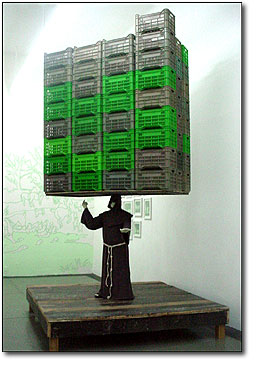Museo de Arte Contemporáneo Carillo Gil ,
Feb 11, 2004 - May 09, 2004
Mexico, D.F., Mexico
Caddy Attacked by Queltehues: Cristián Silva at the Carrillo Gil
by Ichiro Irie
As you emerge to the top level of Museo de Arte Carrillo Gil, you witness something ominous and peculiar. What appears to be a person draped from head to toe in plaid felt blankets -of the most common sort you would find in many Latin America- is standing there motionless. No sooner do you realize that there is really no living human underneath the cloths, and that you are witnessing the first visible object in the first solo exhibition in the Museo Carrillo Gil of Guadalajara based Chilean artist, Cristián Silva. Nevertheless, one cannot help but feel there is a living, breathing, albeit somewhat hot and uncomfortable person inside, making for a compelling introduction into Silva’s world. The piece is actually part of a series of six sculptures entitled "Seis Hermanos (Six Siblings)," representing him and his five brothers and sisters who currently live isolated from each other around the world and in their native home of Chile. The six sculptures, which are somehow reminiscent of Rodin’s "Burghers of Calais," vary only in posture, and are dispersed throughout the exhibition space, mirroring Silva and his 5 siblings’ condition of separation, interconnectedness and loss of identity, which serves only as a hidden signifier of class and perhaps nationality. These kind of blankets, I discovered later, were also used as a means of beating and torturing prisoners during Pinochet’s dictatorship, to ensure that the victims never knew where the next blow would come from or by whom they were being attacked. This series alone contains many of the themes and motifs which Silva is preoccupied with in his body of work, including the use of plaid as a metaphor for the social grid that preordains social status in peripheral societies. Tartan plaid is a material that is also of interest to Silva, because of its Scottish origins, whose patterns indicate lineage and affiliation with the many aristocratic clans in Scotland. This fabric, which is nowadays used as the most non-aristocratic and common of patterns and materials, becomes a strange mutation of social signifiers for Silva. Another motif that is visible throughout almost the entire exhibition is the swamp/toothpaste color green, which in Chile is predominantly used in public institutions such as hospitals and schools. The number 17 also recurs in many of Silva’s pieces, which for the artist has some kind of rather mystical significance, representing amongst other issues, his date of birth, August 17, and also the number of years of military dictatorship under Pinochet. A prominent piece in the show was aptly entitled "The Raft of the Medusa" where the numbers 1 and 7 were molded out of chocolate and placed on green heavy duty fold up chairs mounted on some old wooden rack (these chairs are quite different from the light weight fold up chairs frequently found in cafeterias and gymnasiums in the United States, and aside from being near impossible to unfold, they have the unique quality of, at once, being durable, rigid and completely tacky). Although the actual meaning of this particular piece seems quite cryptic, the decadent melting blocks of chocolate forming the number 17 floating on top of these unsightly chairs definitely calls one’s attention. Another motif that recurs in Silva’s work is that of golf, which brings us to the title piece of the exhibition, "Caddy Attacked by Queltehues." In the circular format video embedded into the museum wall, a caddy waits patiently for his employer, while two crow-looking birds continuously dive on him. The caddy represents an in between strata in society, a hired servant for the wealthy golfer, a contemporary house slave, as opposed to the field slave picking cotton or the manual laborer working for minimum wage (while the "queltehues" are a native species of Chilean
|











